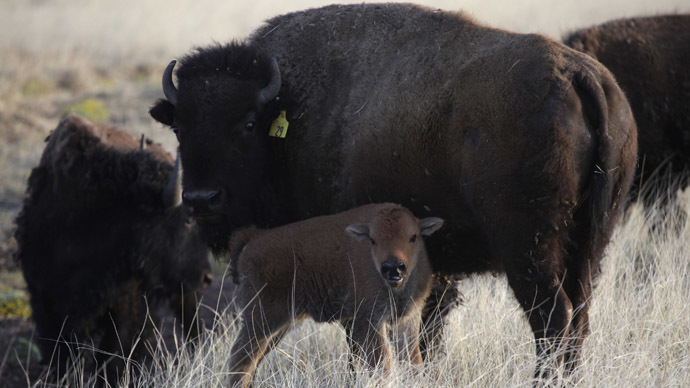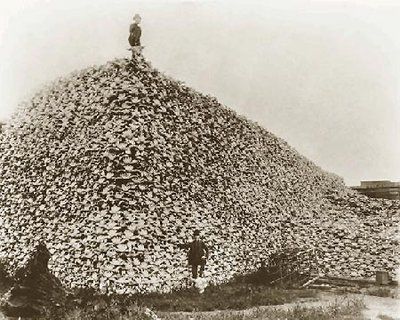
The new 'Buffalo Treaty' was signed this week by 11 tribes hailing from the state of Montana and Canada's Alberta province, according to the Associated Press.
Ultimately, the Native American tribes and their indigenous Canadian counterparts - known as the First Nations in Canada - hope to restore the ability of bison to roam freely between the US/Canada border and re-establish the animal's important position at the center of the tribes' cultures.
"Hunting practices, ceremonies, songs - those things revolved around the buffalo. Sacred societies used the buffalo as a totem. All of these things are going to be revised, revitalized, renewed with the presence of buffalo," Leroy Little Bear, a professor emeritus of Native American studies at the University of Lethbridge and Alberta Blood Tribe member, said to the AP.
Although there's no timetable regarding this plan, the signing of the treaty was welcomed as a positive development between the indigenous groups and a hopeful sign for the future.
"It shows support that we're all (together) as Indian nations, that we can all be together supportive of the others and we have one big thing in common, and that's buffalo and what they mean to us culturally and spiritually. It shows the cohesiveness that the tribes can come together and do this together," Blackfeet Bison Program Manager Ervin Carlson told Montana's KRTV News.
Comment: This is what these psychopathic colonialists did to the Native Americans and the buffaloes.
Robert Kirkconnell, author of American Heart of Darkness, writes:
Most natives died from the period after the Civil War to the early 20th century (about 50 years). This was when the likes of William Tecumseh Sherman masterminded the slaughter of about 30 million buffalo for the purpose of starving out the plains Indians. This was deliberate. I found it in his memoirs and his personal papers. It was the largest slaughter of mammals in the history of the world, and he said it was the only way to be done with the Indians and their "useless way of life." This fit right into the belief systems of his Calvinist ancestors. Sherman and his like did not buy any land what-so-ever. They stole it. It was interesting that he noted that all of his troops from the Civil War were no match for the Comanche, and the only way to beat them was to destroy their food source. He had already practiced "total warfare" against the South. The Union Pacific railroad was built largely for the purpose of transporting so-called Buffalo hunters, a repulsive collection of animals in human form.See: War against the weak
While tribal members are optimistic, their proposal is likely to draw opposition from the livestock industry, which has generally pushed back against plans to reintroduce buffalo populations. Ranchers argue that bison pose a threat to their cattle herds because of the potential for the animals to spread disease. They're also sensitive to the idea that free-roaming bison could end up competing for food with their own grazing cattle.
Ervin Carlson, president of the 56-tribe strong InterTribal buffalo council, acknowledged that bringing the bison back will take time.
"I can't say how many years. It's going to be a while and of course there's such big resistance in Montana against buffalo," said Carlson, also a Blackfeet tribe member. "But within our territory, hopefully, someday."
Collectively the signatories of the treaty control over 6 million acres of prairie habitat across the US and Canada, according to the Wildlife Conservation Society.
Indigenous tribes aren't the only groups interested in repopulating the Great Plains with buffalo. The US Interior Department is also considering a plan that would potentially allow new, disease-free bison herds to repopulate much of the land they used to roam through. The proposal is based on the idea that the government can move various herds to external sites, where they would be quarantined for years in an attempt to keep disease from spreading.
If disease can be successfully stomped out, the healthy buffalo would be taken to other parts of the west, where they could re-establish themselves.




..... let's bring back the Native Americans, too!
Last time I looked, the Native American population is nowhere near where it was at its zenith, before being utterly decimated by those lovely European colonists and their diseases and relentless penchant for slaughtering/enslaving the native peoples they encounter when scouring the world for new areas to enslave, rape and plunder.
I'd love to see a restoration of the Native Americans to their previous position of total power and control over North America. I strongly suspect they'd be a helluva lot better for the world in general, and North America in particular, than the murderous, lying thieves, scoundrels and whack-jobs who make up the current PTB.
(Sorry. Kinda got lost in a fantasy world there. Guess I was just pipe-dreamin' on a cold, windy early spring morning.......... )